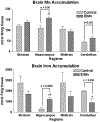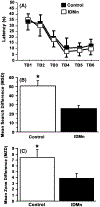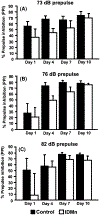A chronic iron-deficient/high-manganese diet in rodents results in increased brain oxidative stress and behavioral deficits in the morris water maze
- PMID: 19384579
- PMCID: PMC7909613
- DOI: 10.1007/s12640-009-9017-1
A chronic iron-deficient/high-manganese diet in rodents results in increased brain oxidative stress and behavioral deficits in the morris water maze
Abstract
Iron deficiency (ID) is especially common in pregnant women and may even persist following childbirth. This is of concern in light of reports demonstrating that ID may be sufficient to produce homeostatic dysregulation of other metals, including manganese (Mn). These results are particularly important considering the potential introduction of the Mn-containing gas additive, methyl cyclopentadienyl manganese tricarbonyl (MMT), in various countries around the world. In order to model this potentially vulnerable population, we fed female rats fed either control (35 mg Fe/kg chow; 10 mg Mn/kg chow) or low iron/high-manganese (IDMn; 3.5 mg Fe/kg chow; 100 mg Mn/kg chow) diet, and examined whether these changes had any long-term behavioral effects on the animals' spatial abilities, as tested by the Morris water maze (MWM). We also analyzed behavioral performance on auditory sensorimotor gating utilizing prepulse inhibition (PPI), which may be related to overall cognitive performance. Furthermore, brain and blood metal levels were assessed, as well as regional brain isoprostane production. We found that treated animals were slightly ID, with statistically significant increases in both iron (Fe) and Mn in the hippocampus, but statistically significantly less Fe in the cerebellum. Additionally, isoprostane levels, markers of oxidative stress, were increased in the brain stem of IDMn animals. Although treated animals were indistinguishable from controls in the PPI experiments, they performed less well than controls in the MWM. Taken together, our data suggest that vulnerable ID populations exposed to high levels of Mn may indeed be at risk of potentially dangerous alterations in brain metal levels which could also lead to behavioral deficits.
Figures






Similar articles
-
Neurobehavioral effects of lead and manganese individually and in combination in developmentally exposed rats.Neurotoxicology. 2012 Oct;33(5):1117-27. doi: 10.1016/j.neuro.2012.06.002. Epub 2012 Jun 23. Neurotoxicology. 2012. PMID: 22732189
-
Iron deficient and manganese supplemented diets alter metals and transporters in the developing rat brain.Toxicol Sci. 2007 Jan;95(1):205-14. doi: 10.1093/toxsci/kfl139. Epub 2006 Oct 23. Toxicol Sci. 2007. PMID: 17060373
-
Measuring brain manganese and iron accumulation in rats following 14 weeks of low-dose manganese treatment using atomic absorption spectroscopy and magnetic resonance imaging.Toxicol Sci. 2008 May;103(1):116-24. doi: 10.1093/toxsci/kfn019. Epub 2008 Jan 30. Toxicol Sci. 2008. PMID: 18234737 Free PMC article.
-
Biomarkers of manganese intoxication.Neurotoxicology. 2011 Jan;32(1):1-8. doi: 10.1016/j.neuro.2010.10.002. Epub 2010 Oct 12. Neurotoxicology. 2011. PMID: 20946915 Free PMC article. Review.
-
Iron and manganese-related CNS toxicity: mechanisms, diagnosis and treatment.Expert Rev Neurother. 2019 Mar;19(3):243-260. doi: 10.1080/14737175.2019.1581608. Epub 2019 Feb 21. Expert Rev Neurother. 2019. PMID: 30759034 Free PMC article. Review.
Cited by
-
Manganese-induced Neurotoxicity: From C. elegans to Humans.Toxicol Res (Camb). 2015 Mar 1;4(2):191-202. doi: 10.1039/C4TX00127C. Toxicol Res (Camb). 2015. PMID: 25893090 Free PMC article.
-
Cumulative risk assessment as the pathway to public health protection for behavioral neurotoxicity.Neurotoxicology. 2025 May;108:400-411. doi: 10.1016/j.neuro.2025.04.015. Epub 2025 May 10. Neurotoxicology. 2025. PMID: 40349850 Review.
-
The effects of a high-energy diet on hippocampal function and blood-brain barrier integrity in the rat.J Alzheimers Dis. 2010;21(1):207-19. doi: 10.3233/JAD-2010-091414. J Alzheimers Dis. 2010. PMID: 20413889 Free PMC article.
-
Subchronic Manganese Exposure Impairs Neurogenesis in the Adult Rat Hippocampus.Toxicol Sci. 2018 Jun 1;163(2):592-608. doi: 10.1093/toxsci/kfy062. Toxicol Sci. 2018. PMID: 29579278 Free PMC article.
-
Effects of Nano-MnO2 on dopaminergic neurons and the spatial learning capability of rats.Int J Environ Res Public Health. 2014 Aug 6;11(8):7918-30. doi: 10.3390/ijerph110807918. Int J Environ Res Public Health. 2014. PMID: 25101772 Free PMC article.
References
-
- Anderson JG, Cooney PT, Erikson KM (2007) Brain manganese accumulation is inversely related to gamma-amino butyric acid uptake in male and female rats. Toxicol Sci 95:188–195 - PubMed
-
- Beard JL, Connor JR (2003) Iron status and neural functioning. Annu Rev Nutr 23:41–58 - PubMed
-
- Bolte S, Normandin L, Kennedy G, Zayed J (2004) Human exposure to respirable manganese in outdoor and indoor air in urban and rural areas. J Toxicol Environ Health A 67:459–467 - PubMed
-
- Boudia N, Halley R, Kennedy G, Lambert J, Gareau L, Zayed J (2006) Manganese concentrations in the air of the Montreal (Canada) subway in relation to surface automobile traffic density. Sci Total Environ 366:143–147 - PubMed
MeSH terms
Substances
Grants and funding
LinkOut - more resources
Full Text Sources

